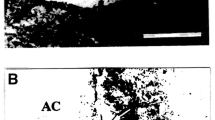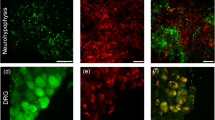Abstract
The responsiveness of spontaneously active neurons in the subfornical organ (SFO) of adult ducks to angiotensin II (ANGII) and the bird specific anti-diuretic hormone, arginine vasotocin (AVT), the analog of the mammalian arginine vasopressin (AVP), were investigated in brain slices with extracellular recording technique. 65% (n = 66) of the neurons increased their activity after superfusion with ANGII, the rest were unresponsive. Application of AVT activated 52% (n = 68) of the investigated neurons and like ANGII never caused an inhibition of the spontaneously active SFO neurons. A close correlation exists between the ANGII and AVT sensitivity of duck SFO neurons, because 29 out of 33 neurons were excited by AVT as well as ANGII. The relatively weak antagonistic effect of the V1-type receptor antagonist Pmp-Tyr (Me)-Arg8-vasopressin on the AVT induced excitation suggests a different pharmacology of the bird AVT receptor as compared to the mammalian AVP receptor. The excitatory response of ANGII and AVT on the very same neurons suggest a similar function of both peptides on SFO mediated effects in vivo, such as an increase in water intake. However, peripheral AVT concentrations, unlike ANGII concentrations in the blood are not high enough to activate SFO neurons from the blood side of the blood brain barrier. Therefore AVT is presumably released from synapses of neurons originating within or projecting to the SFO. The identity of the ANGII and AVT reactive neurons suggests that synaptically released AVT should facilitate SFO mediated drinking.
Similar content being viewed by others
Abbreviations
- a CSF :
-
artificial cerebrospinal fluid
- ANGII :
-
angiotensin II
- AVT :
-
arginine vasotocin
- AVP :
-
arginine vasopressin
- ADH :
-
antidiuretic hormone
- SFO :
-
subfornical organ
- AVP 4–9 :
-
arginine-vasopressin fragment 4–9
- BBB :
-
blood-brain barrier
References
Burbach JPH (1987) Metabolic processing of vasopressin in the brain and significance of metabolites. In: Gash DM, Boer GJ (eds) Vasopressin: principles and properties. Plenum press, New York, pp 497–516
Burnier M, Biollaz J, Brunner DB, Brunner HR (1983) Blood pressure maintenance in awake dehydrated rats: renin, vasopressin and sympathetic activity. Am J Physiol 245: H203-H209
Eriksson S, Simon-Oppermann C, Simon E, Gray DA (1987) Interaction of changes in the third ventricular CSF tonicity, central and systemic AVP concentrations and water intake. Acta Physiol Scand 130: 575–583
Fahrenholz F, Jurzak M, Gerstberger R, Haase W (1993) Renal and central vasopressin receptors — immunocytochemical localization. Ann New York Acad Sci 689: 194–206
Fitzsimons JT(1980) Angiotensin stimulation of the central nervous system. Rev Physiol Pharmacol 87: 117–167
Gerstberger R, Fahrenholz F (1989) Autoradiographic localization of VI vasopress in binding sites in rat brain and kidney. Europ J Pharmacol 16: 105–116
Gerstberger R, Müller AR, Simon-Oppermann C (1992) Functional hypothalamic angiotensin II and catecholamine receptor systems inside and outside the blood-brain barrier. Prog Brain Res 91: 423–433
Gerstberger R, Bender R, Jurzak M, Keil R, Küchenmeister I, Schütz H (1994) Modulation of avian renal salt and water elimination by arginine vasotocin, mesotocin and ADH receptor subtype-specific analogues. In: Pleschka K, Gerstberger R (eds) Integrative and cellular aspects of autonomic functions: temperature and osmoregulation. John Libbey Eurotext, Paris, pp 533–542
Ishikawa SE, Goldberg J, Schrier DM, Aisenbrey GA, Schrier RW (1984) Interrelationship between subpressor effects of vasopressin and other vasoactive hormones in the rat. Mineral Electrolyte Metab 10: 184–189
Jurzak M, Fahrenholz F, Gerstberger R (1993) Vasopressin antiidiotypic antibody staining in the rat brain: colocalization with [35S] [pGlu4, Cyt6] AVP(4–9) binding-sites. J Neuroendocrinol 5: 523–531
Kirk KL, Schafer JA (1992) Water transport and osmoregulation by antidiuretic hormone in terminal nephron segments. In: Seldin DW, Giebisch G (eds) The kidney: physiology and pathophysiology. Raven Press, New York, pp 1693–1725
Laczi F, Gaffori O, deKloet R, de Wied D (1983) Differential responses in immunoreactive arginine-vasopressin content of microdissected brain regions during passive avoidance behaviour. Brain Res 260: 342–346
Leonhardt H (1980) Ependym und circumventriculäre Organe. In: Oksche A, Vollrath L (eds) Handbuch der mikroskopischen Anatomie des Menschen. Springer, Heidelberg, pp 177–666
Lepetit P, Fevremontange M, Gay N, Belin MF, Bobillier P (1993) Vasopressin messenger-rna in the cerebellum and circumventricular organs — a quantitative in-situ hybridization study. Neurosci Lett 159: 171–174
Lind RW, vanHoesen GW, Johnson AK (1982) An HRP study of the connections of the subfornical organ of the rat. J Comp Neurol 210: 265–277
Matsumura K, Simon E (1990a) Locations and properties of angiotensin II-responsive neurones in the circumventricular region of the duck brain. J Physiol (Lond) 429: 281–296
Matsumura K, Simon E (1990b) Increase in basal firing rate and sensitivity to angiotensin II in subfornical organ neurons of ducks adapted to salt water. J. Physiol (Lond) 429: 297–308
McKinley MJ, McAllen RM, Mendelsohn FAO, Allen AM, Chai SY, Oldfield BJ (1990) Circumventricular organs: Neuroendocrine interfaces between the brain and the hemal milieu. Frontiers in Neuroendocrinology 11(2): 91–127
Müller AR, Schäfer F, Schmid HA, Gerstberger R (1994) Osmosensitive circumventricular structures connected to paraventricular nucleus in the duck brain. In: Pleschka K, Gerstberger R (eds) Integrative and cellular aspects of autonomic functions: temperature and osmoregulation. John Libbey Eurotext, Paris, pp 439–449
Oksche A, Leonhardt H, Niessing K, Scharrer E, Scharrer B, Weitzman M, Wittkowski W (1980) Handbuch der mikroskopischen Anatomie des Menschen, Band 4, Nervensystem 10.Teil, Springer, Berlin Heidelberg New York
Okuya S, Inenaga K, Kaneko T, Yamashita H (1987) Angiotensin II sensitive neurons in the supraoptic nucleus, subfornical organ and anteroventral third ventricle of rats in vitro. Brain Res 402: 58–67
Phillips MI (1987) Functions of angiotensin in the central nervous system. Annu Rev Physiol 49: 413–435
Rolls BJ (1971) The effect of intravenous infusion of antidiuretic hormone on water intake in the rat. J Physiol (Lond) 219: 331–339
Schmid HA, Schäfer F, Simon E (1995) Excitatory and inhibitory responses caused by norepinephrine in the duck SFO are medited by beta- and alpha2- adrenoceptor activation. J Comp Physiol A 176: 149–158
Schmid HA, Simon E (1992) Effect of angiotensin II and atrial natriuretic factor on neurons in the subfornical organ of ducks and rats in vitro. Brain Res 588: 324–328
Simon E, Gerstberger R, Gray DA (1992) Central nervous angiotensin II responsiveness in birds. In: Kerkut GA (ed) Progress in Neurobiology, 39. Pergamon Press, Oxford, pp 179–207
Simon-Oppermann C, Simon E, Gray DA (1988) Central and systemic antidiuretic hormone and angiotensin II in salt and fluid balance of birds as compared to mammals. Comp Biochem Physiol 90A: 789–803
Summy-Long JY, Keil LC, Severs WB (1978) Identification of vasopressin in the subfornical organ region: effects of dehydration. Brain Res 140: 241–250
Summy-Long JY, Keil LC, Hernandez L, Emmert S, Chee O, Severs WB (1984) Effects of dehydration and renin on vasopressin concentration in the subfornical organ area. Brain Res 300: 219–229
Szczepanska-Sadowska E, Sobocinska J, Sadowski B (1982) Central dipsogenic effect of vasopressin. Am J Physiol 242: R372-R379
Weindl A, Sofroniew MV (1982) Peptide neurohormones and circumventricular organs in the pigeon. Front Horm Res 9: 88–104
Weindl A, Sofroniew MV (1985) Neuroanatomical pathways related to vasopressin. In: Ganten D, Pfaff D (eds) Neurobiology of vasopressin. Springer, Berlin, pp 137–196
Author information
Authors and Affiliations
Rights and permissions
About this article
Cite this article
Schmid, H.A., Schäfer, F. & Simon, E. Excitatory action of the bird antidiuretic hormone vasotocin on neurons in the subfornical organ. J Comp Physiol A 176, 653–660 (1995). https://doi.org/10.1007/BF00192494
Accepted:
Issue Date:
DOI: https://doi.org/10.1007/BF00192494




